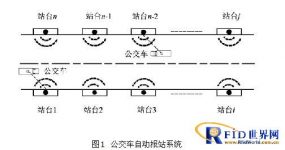
Design of automatic bus stop reporting system based on ZigBee technology
[ad_1]
With the rapid development of my country’s economy, the opportunities for people to go out are gradually increasing, and the role of public buses in daily life is becoming more and more prominent, which puts forward higher requirements for the safe operation of urban public transport systems. At present, unmanned ticket sales are implemented on buses in many cities above the middle level, and bus drivers are more responsible for driving safety. This makes it urgent to install automatic stop announcers on every bus. In recent years, domestic scholars have gradually carried out research work in this area, using single-chip microcomputer, embedded processor, wireless sensor network and GPS technology to design various automatic bus stop reporting systems, which have played a very good role in the development of urban public transportation. enhancement. However, most of the bus lines in small and medium-sized cities have not yet fully adopted automatic stop reporting systems, and there is an urgent need for automatic stop reporting devices that are low in cost, reliable in operation, easy to maintain, and easy to promote.
In view of the characteristics of the public transportation system in small and medium-sized cities, the author combines the single-chip microcomputer and ZigBee technology to design a low-cost automatic stop announcer based on ZigBee technology, which has the advantages of both manual and automatic stop announcers, and is suitable for large-scale popularization applications.
1 Overall plan
There are many bus stations on the main streets of the city. One station may have to stop at multiple lines of buses, and the name of the same station may be different on each line. Therefore, the station address coding information needs to be dynamic with an 8-bit dial switch. Set so that each bus will automatically recognize the current position in the line. Figure 1 shows a schematic diagram of an automatic bus stop reporting system with n stations.

Due to the narrow roads in small and medium-sized cities, the bus may receive multiple station address coding information at the same time during its travel. As shown in Figure 1, a bus driving to the right will receive the coding information of platform 1 and platform n at the same time. At this time, it can be automatically determined by the direction of travel that the coded information of the platform 1 is valid. The driving direction of the vehicle can be identified by prefabrication or station address increment (decrement). If there is a sudden change in the coding, it means that the vehicle may not be able to automatically report the stop and use the manual stop, so that the system can record the station’s information Code for timely repair.
This system is divided into two parts: vehicle-mounted and platform. The vehicle-mounted part adopts the control module with MSP430F149 single-chip microcomputer as the core; the platform part only needs to transmit station address coding information, which requires low power consumption, low cost, high reliability and easy maintenance, so ZigBee transmission The module is composed of CC2430 chip as the core. Figure 2 shows the block diagram of the design of the automatic stop reporting system for buses.

2 hardware design
2.1 Site coded information transmitter
The hardware design of the site coded information transmitter is shown in Figure 3. It is mainly composed of ZigBee transmitter module, crystal oscillator, impedance matching network, antenna and battery. ZigBee selects Chipcon’s CC2430 chip, which extends the architecture of the previous CC2420 chip. It integrates ZigBee RF front-end, memory and microcontroller (enhanced 8051 core) on a single chip. It is produced using 0.18 mCMOS process and is in launch mode. The down current consumption is less than 25mA, and it has the ultra-short time characteristic of switching from sleep time mode to active mode. It is especially suitable for occasions requiring very long battery life. 2 AA batteries can be used for up to 2a.

The CC2430 chip is connected to a 32MHz crystal oscillator, and the site code data is dynamically set through the 8-bit dial switch SW, and is sent out through the antenna after being processed by the impedance matching network. The coverage can reach tens of meters.
The hardware design method has the characteristics of simple circuit, stable signal, low cost and easy installation.
2.2 Vehicle-mounted automatic stop announcer
The hardware design of the vehicle-mounted automatic station announcer is shown in Figure 4 (except the keyboard and display module).

The one-chip computer adopts TI Company’s MSP430F149 chip, its power consumption current is μA level. The MSP430 core is a 16-bit CPU with an efficient RISC instruction system and unified interrupt management. There are precision hardware multipliers, two 16-bit timers, a 14-channel 12-bit analog-to-digital converter, and a watchdog on-chip. , Six parallel ports, two USART communication ports, a comparator, two external clocks and 60kB flash memory, two of which can work in UART and SPI modes.
The ZigBee receiving module uses the CC2420 chip, which has a fully integrated voltage-controlled oscillator, and only needs a few peripheral circuits such as an antenna and a 16MHz crystal oscillator to work in the 2.4GHz frequency band. CC2420 only provides a SPI interface to connect with the microprocessor, through this interface to complete the settings and send and receive data. MSP430F149 integrates an SPI controller, which can be easily used in conjunction with CC2420.
The clock chip adopts DS1302, which is a serial clock calendar chip with high performance, low power consumption, RAM and leap year compensation function based on I2C bus developed by DALLAS company. The year, month, day, week, time can be generated internally. Time stamp data such as, minutes and seconds are stored in the corresponding registers, and the single-chip microcomputer can read these data directly.
The temperature sensor adopts DS18B20, which is a one-wire single-bus intelligent digital temperature sensor produced by DALLAS. It has the advantages of miniaturization, low power consumption, high performance, and strong anti-interference ability. The temperature measurement range is -55℃~+125℃. -10℃~+80℃, the measurement accuracy is 0.5℃. After the single-chip microcomputer sends out the temperature conversion instruction, the DS18B20 saves the measured temperature value in two units, MSB (high 8 bits) and LSB (low 8 bits), which can be read directly by the single chip microcomputer.
The main part of the LED dot matrix display module is the display array and the row and column drive circuit. The display array of this design is a 16-row×64-column monochrome dot matrix. The row drive circuit is composed of MC74HC138 chip, TC74HC04 chip and transistor NPN9013. The column drive circuit is composed of M74HC595 chip. It adopts dynamic scanning driving mode, which can display dynamically and in real time. Information such as site, current temperature, date and time.
The USB interface chip selects PDIUSBDI2, which is one of the most used chips by Philips on the USB1.1 protocol device side. It meets the specifications of most device classifications and can be used on U disks. PDIUSBDI2 integrates many features, including programmable clock output, low-frequency crystal oscillator, endpoint registers, analog transceiver, voltage regulator, bit clock reset, serial interface engine, memory management unit, SoftConnect, GoodLink and integrated RAM. The internal contains 3 There are two endpoints, and each endpoint has two endpoints, input and output. The indexes 0 and 1 of endpoint 0 are control input and output endpoints, which are used to transmit USB control commands and complete USB enumeration; the indexes 2 and 3 of endpoint 1 are common input and output endpoints, and the indexes 4 and 5 of endpoint 2 It can be configured as a normal input and output endpoint, a synchronous input endpoint, a synchronous output endpoint, or a synchronous input and output endpoint. The buffer size of endpoint 0 and endpoint 1 is 32kB, and the buffer size of endpoint 2 is 128kB, and it is double buffered. The transmission of USB data is carried out through these endpoints.
The voice power amplifier module includes voice chips, power amplifiers, speakers, etc. The voice chip uses the ISD4003 integrated chip, which has few voice signal connections. The recording and playback time of a single chip is 4~8min. The chip adopts multi-level direct analog storage technology. Each sample value is directly stored in the on-chip flash memory. Really and naturally reproduce the voice signal. The power amplifier chip uses the TDA2822 dual-channel audio power amplifier circuit, which has a wide operating voltage range and is suitable for working at low power supply voltages, with low crossover distortion and low quiescent current, and the maximum output power can reach 3W.
3 software design
The software process of the vehicle part is shown in Figure 5, mainly including: system initialization program, keyboard interrupt service program (manual station reporting part), ISD4003 voice playback program, U disk management program, LED display program and reading DS1302, DS18B20, CC2420, etc. Subroutine. The software workflow of the platform part is relatively simple, so I won’t describe it here.

4 Conclusion
1) The design of the platform part adopts the CC2430 chip to realize the automatic transmission of the site code information, with few peripheral circuits, and can be powered by batteries for a long time, with low cost, reliable operation and easy installation and maintenance.
2) The vehicle-mounted part can easily switch the bus lines through the line information stored in the U disk. The LED dot matrix display effect is good. It can display the station name, calendar, time, week and temperature information in real time while automatically reporting the station. Improve practicality and make bus service more humane.
3) According to the characteristics of the public transportation system in small and medium-sized cities and the actual operating environment, considering the performance-price ratio and practicability, a single-chip automatic station reporting system based on ZigBee technology is designed. It has strong scalability and low cost, which is very suitable for large-scale promotion and use.
[ad_2]




